Click on thumbnail
for full size image |
Size |
Image Description |
Source |
| PT-9 |
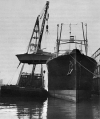 |
158k |
The Navy's first PT boat, the Scott-Paine PT 9, is unloaded from SS President Roosevelt in New York, September 5, 1939
ELCO Naval Division, Electric Boat Co. photo from "At Close Quarters PT Boats in the United States Navy" by Captain Robert J. Bulkley, Jr., USNR (Retired) |
Robert Hurst |
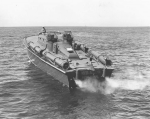 |
141k |
c. 1939
Undergoing test runs off of New York |
Bill Gonyo |
 |
18k |
|
|
 |
60k |
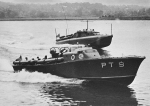 |
115k |
PT-3 and PT-9 during test runs |
 |
128k |
PT-3 and PT-9 during test runs
From the collection of Robert C. Houston |
Bob Houston |
 |
36k |
Note the extreme similarity between this boat and the 70' Electric Boat Co., Elco Works, PT boats. The most notable differences are the short pilothouse and small
turret domes
Elco photo from "Allied Coastal Forces of World War II: Vosper MTBs and U.S. Elcos" by John Lamber and Al Ross |
Robert Hurst |
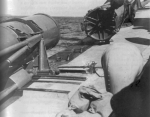 |
82k |
Seen here are the 18" torpedo tubes on PT-9. The torque rods and training gear are clearly shown. The ten 70'-PTs mounted nearly identical tubes
U.S. Navy photo from "Allied Coastal Forces of World War II: Vosper MTBs and U.S. Elcos" by John Lamber and Al Ross |
 |
58k |
Seen here are the original Dewandre turret dome on PT-9. Note the relatively small size and the .30 cal. Browning guns
U.S. Navy photo from "Allied Coastal Forces of World War II: Vosper MTBs and U.S. Elcos" by John Lamber and Al Ross |
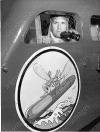 |
94k |
LCDR Earl S. Caldwell
Photo from argentaImages |
Bill Gonyo |
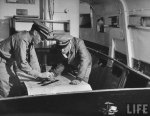 |
115k |
c. 1940
LT James D. Ball (left) and LCDR Earl S. Caldwell (right)
Life magazine photo |
Jerry Gilmartin, MMC, USN, Ret. |
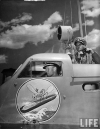 |
121k |
c. 1940
LCDR Earl S. Caldwell (in cockpit)
Life magazine photo |
 |
395k |
19 June 1940
PT-9 with the Under Secretary of the Navy embarked
U.S. Navy photo |
Jim Kurrasch, Battleship Iowa, Pacific Battleship Center |
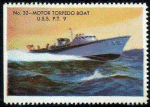 |
50k |
Advertisement stamp |
Tommy Trampp
Photo added 17 March 2020 |
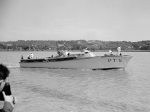 |
133k |
PT-9 with the Under Secretary of the Navy embarked
Photo caption: New 'Mosquito Boat' ready for action. Washington, D.C., June 19, [1940]. The PT-9, first of the American Motor Torpedo Boats to be delivered to the U.S. Navy under the President's $15,000,000 experimental small craft program had a preview showing for the press today. The 'Mosquito Boat' and eight other ones will be based at the Naval Operating Base, Norfolk, Va., where they will undergo service tests under various sea conditions to determine their capabilities and limitations. This is the same type of boat that the government is in the process of releasing to the British Navy. Chairman David L. Walsh of the Senate Naval Affairs Committee expressed indignation over the Navy's action in this respect in view of the fact that this government is trying to build up its own sea power
Photo courtesy of the Library of Congress |
Bill Gonyo |
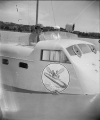 |
125k |
19 June 1940
Photo caption: The PT-9, first of the new 'Mosquito Boats' to be delivered to the U.S. Navy under the President's $15,000,000 experimental small craft program had a preview for the press today. This is the same type of boat that the government is in process of releasing to the British Navy, causing great unrest and indignation in Capitol circles. Eight other boats will be based at the naval operating base, Norfolk, Va., to undergo severe seagoing tests. The squadron will be known as the Mosquito Fleet and the insignia which was designed by Walt Disney consists of a mosquito riding on the top of a high speed torpedo. Shown in the picture is Lieutenant Earl S. Caldwell, USN, Commander of the squadron
Library of Congress photo |
 |
210k |
The British built, experimental PT-9 underway in mid-1940 during trials, after being placed in service and assigned to MTBRon 1 for evaluations
Life Magazine Archives - Thomas McAvoy Photographer, shared by Peter DeForest |
Mike Green |
 |
201k |
Port side closeup of PT-9 underway in mid-1940 during trials
Life Magazine Archives - Thomas McAvoy Photographer, shared by Peter DeForest |
 |
192k |
Port bow overhead view of PT-9 underway in 1940 during trials. PT-9, built in Hampshire, England, was an Experimental Motor Torpedo Boat and assigned to MTBRon 1 for evaluations, later being assigned to MTBRon 2
Life Magazine Archives - Thomas McAvoy Photographer, shared by Peter DeForest |
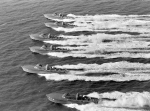 |
224k |
PT-12, PT-13, PT-14, PT-15, PT-19 and PT-9 underway at speed in late 1940-early 1941, assigned to MTBRon 2
Life Magazine Archives - Thomas McAvoy Photographer, shared by Peter DeForest |
 |
225k |
PT-9, PT-11 and PT-12 underway in New York Harbor, circa late 1940. Statue of Liberty is in the background
Naval History and Heritage Command photo NH 44950 |
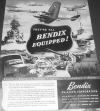 |
155k |
c. 1941
Bendix Aviation Corporation advertisement |
Tommy Trampp |
 |
99k |
Seventy-foot Elcos of MTBRon 2 at the Washington Navy Yard in January 1941. PT-9 is against the pier in the second row inboard and can be distinguished by its smaller turret domes and low pilothouse
Naval History and Heritage Command photo from "Allied Coastal Forces of World War II: Vosper MTBs and U.S. Elcos" by John Lamber and Al Ross |
Robert Hurst |
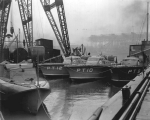 |
230k |
PT-3, PT-12, PT-10 and PT-9 probably in the New York Navy Yard, Brooklyn, NY |
Keith Brayer |
| HMC S-09 |
 |
61k |
Photo from The Ships of Canada's Naval Forces 1910-1981 by Ken Macpherson & John Burgess |
Joe Radigan |



